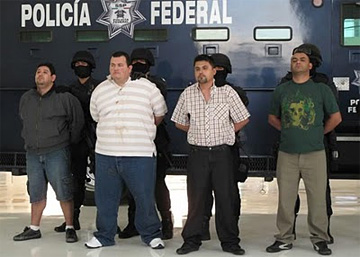
|  |  |  News Around the Republic of Mexico News Around the Republic of Mexico  
In Mexico, Drug-War Suspects Face a Ritual Parade
 Ken Ellingwood - Los Angeles Times Ken Ellingwood - Los Angeles Times
go to original
April 03, 2010


| | (L to R) Jose Antonio Rangel Houses, El Chiquilin, Crutches and Ramon Angel Soto Corral |  |
Mexico City - The manhunt was over. Raydel "Crutches" Lopez Uriarte, the alleged top enforcer for a vicious Tijuana drug gang that dissolved victims in lye, would now have to face justice.

First, though, he would have to face the media.

A day after his arrest, Lopez found himself standing woodenly, with his hands cuffed behind him, as news photographers snapped away at him and three others arrested in the same raid.

The 30-year-old Lopez, one of the most dreaded figures on the border, had a trim goatee and combed hair and wore a sensible checkered shirt and dark jeans that looked like they were meant for someone half a head taller. He appeared more annoyed than menacing, like a sullen student summoned for an unwelcome yearbook picture.

The spectacle, covered live on Mexican television, lasted only as long as it took a federal police official to read a statement and take a few questions about the Feb. 8 arrest, hailed by authorities as a major achievement in the war on drug cartels launched in late 2006.

The images were on TV all day.

The ritual is called a presentacion, Spanish for "presentation" or "introduction," though no one ever shakes hands. Almost daily, one of the thousands of suspects who have been rounded up in the drug war is paraded in front of cameras, posed with seized weapons and contraband and even grilled by police officers while reporters jot down answers that are often self-incriminating.

Human-rights advocates are appalled by the practice, a more elaborate version of the U.S.-style "perp walk," saying it violates suspects' rights by exhibiting them as if they were guilty before they have even been charged.

Yet for a society haunted by a level of violence not seen since the Mexican Revolution, the presentacion serves as hunter's trophy and modern-day dunking stool, a chance for Mexican authorities to convince crime-weary constituents that they're making the streets safer, and for residents to savor a morsel of justice meted.

It is where shadowy figures made famous by lore and "wanted" posters are at last hauled into the light, sometimes looking as if they had been rousted from bed. (Often, they have.) Think celebrity mug shots, but live.

Luis Garcia Lopez-Guerrero, an official with the National Human Rights Commission, said the growing frequency of presentaciones endangers Mexico's efforts to establish rule of law and cultivate a functioning democracy.

"We don't want to see justice in the media," Garcia said. "We want to feel safe."

The show-and-tell sessions aren't only for drug lords. Around Mexico, authorities at the federal, state and local levels stage hundreds of presentaciones a year as a result of President Felipe Calderon's crackdown, many for smaller-bore offenses such as car thefts and stickups. On a recent day, three men in Mexico City were posed by prosecutors with cases of bottled water they were accused of stealing from victims of recent flooding.

The suspects are made to stare into the camera, usually in front of a backdrop printed with the name and logo of the police agency. (Lopez and the three other Tijuana suspects were posed in front of an armored car belonging to the federal police.)

Those "presented" wear whatever fate clothed them in at the time of their arrest: dingy T-shirts, floppy sandals, sweat pants. Three alleged members of the notorious Zetas gang were made to answer questions before news cameras in swim trunks and bare feet after they were arrested in the Yucatan peninsula in 2008. Two of them were shirtless.

Many suspects show up bruised and scraped.

In a country where people tend to mistrust their leaders, parading a suspect serves as proof that authorities have arrested the person they say they have. And it's catnip for mainstream Mexican media outlets and the publications that focus on crime coverage, a hugely popular specialty known in Mexico as "red news."

Edgar Cordova, an editor at the gore-heavy El Grafico tabloid, said publishing photos of suspects, such as alleged kidnappers, might help counter crime by inviting corroborating reports from other victims. Few Mexicans report crimes, out of fear and mistrust of police.

But the ritual faces growing resistance. Last fall, four justices of Mexico's Supreme Court signed a nonbinding opinion that said exhibiting suspects before they have been charged violates their right to be presumed innocent.

Mexico's Roman Catholic bishops criticized the practice recently, urging officials to treat suspects as innocent until they are proved guilty. "Because now we see that detainees are exhibited before the media before being brought before judicial authorities," the Mexican Council of Bishops said.

"If we really care about the rule of law, we should stop this," said Ernesto Lopez Portillo Vargas, executive director of the Institute for Security and Democracy in Mexico City. "This is a political decision."

Opponents of the practice say the risk that a suspect trotted before cameras will end up being freed is especially high in Mexico because cases frequently fall apart on flimsy evidence. For the innocent, it may be too late to recover their reputations.

But where critics see politically motivated spectacle, Mexican officials see proof of difficult battles won.
|

 |
|  |



